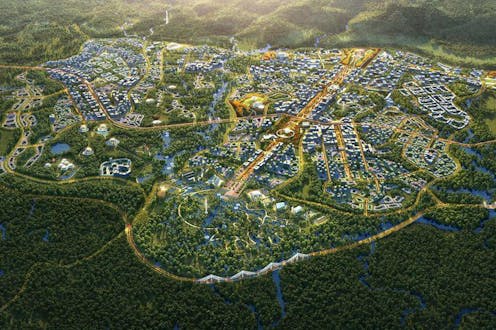
On February 15 2022, President Joko “Jokowi” Widodo signed and promulgated a new law that establishes the new capital city of Indonesia, referred to as “Nusantara”, between Balikpapan and Samarinda in East Kalimantan province.
Jokowi envisioned Nusantara as a sustainable and green city, for which renewable energy will meet almost 40% of electricity demand – far exceeding the national average of 11.5%.
How will Indonesia make its “green energy vision” possible in Nusantara?
Our research suggests the government could consider solar energy potentials while considering wind energy as a complementary source to meet Nusantara’s renewable energy target.
Solar and wind energy: which is most feasible?
In August 2019, Indonesia’s Ministry of Energy and Mineral Resources estimated that the new capital city will need 1,500 megawatts (MW) of electricity generation capacity. Currently, the renewable energy production in the area is close to 0%.
East Kalimantan has enormous potential for clean energy. Research from the Ministry of Energy and Mineral Resources shows that the prospect of hydroelectricity, solar power, wind power, biofuel and other renewable energy sources combined in East Kalimantan alone can reach up to 2,000MW.
Our statistics show hydroelectric potentials comprises 26% of it, and solar power is 65%. We used geospatial data related to the Nusantara’s land-use and terrain characteristics to analyse solar and wind energy potential possibilities.
We found that East Kalimantan’s average wind speeds are generally too low for lucrative wind farm projects. But some areas, particularly in the east of the region, do have good wind conditions
Even though, the area would need to have the right size of wind turbines, which can be transported with the available infrastructure at and to the sites.
Solar energy is more feasible than wind, because the Nusantara region receives huge amounts of sunshine, although obviously not every site in the city is suitable for installing solar energy.
Using geospatial data, we identified high potential areas by excluding sloping areas that are unfit for solar development and certain land-use areas such as forests, wetlands, areas of national protection and planned areas for governmental buildings.
Our study showed that solar projects should be focused on three potential areas:
1) Water bodies, by using floating solar energy up to 22 km2 wide of the areas, including water bodies in mining areas;
2) Mining areas, because solar radiation is generally highest in these areas. With an area of 2.21% of the Nusantara, mining fields have existing electricity distribution, transmission lines and transport infrastructure. The second advantage is the low environmental impact of using already disturbed land in mining areas. In this way, we can save the high costs of the connection to the grid and minimise the environmental impact.
3) Agricultural areas, which make up 1.26% of the usable land. Our research has identified 23 square km of agricultural land that can be used to install solar plants. Farmers and agricultural businesses could collaborate to elaborate personalised solutions depending on crop, location and size. The result can be a win-win situation for farmers, investors, and electricity companies.
What needs to be done
The government must expand stabilised electricity grids to deliver the increased demand. An unstable grid reacts poorly to fluctuating energies such as solar and wind. Currently, East Kalimantan relies on 150 kilovolt (kV) transmission lines. But delivering 1,500MW of power would require a 500kV main transmission line.
The grid constantly needs a particular baseload, which is currently provided by fossil fuels such as coal. This is where innovations are needed.
Two innovative concepts could be adopted:
1) Using microgrids to relieve the national electricity grid.
Many “island systems” – where a local electricity grid operates independently from main grid – run on renewable sources. These microgrids could be linked to the main grid – as was successfully done for solar microgrids in New Delhi, India.
When connecting energy systems, renewable energies can complement or even replace existing electricity systems, and generate stable electricity.
The government could also pursue innovative grid monitoring systems to have a large amount of data available for analysis so that consistent results in electricity consumption can be tracked, and the guidelines are adapted accordingly to the benefit of the city’s development.
2) To achieve the targets for the development of energy infrastructure in the new capital and the country, one could think of stimulating private entrepreneurs to contribute to public tenders for independent power producers (IPPs) on a large scale.
International IPPs and the local provider PLN could work together to achieve the goals. From more renewable energy to less coal, retired power plants can be used for large solar energy sites as they already have infrastructure for connecting to the grid.
Walter Timo de Vries does not work for, consult, own shares in or receive funding from any company or organisation that would benefit from this article, and has disclosed no relevant affiliations beyond their academic appointment.
This article was originally published on The Conversation. Read the original article.







